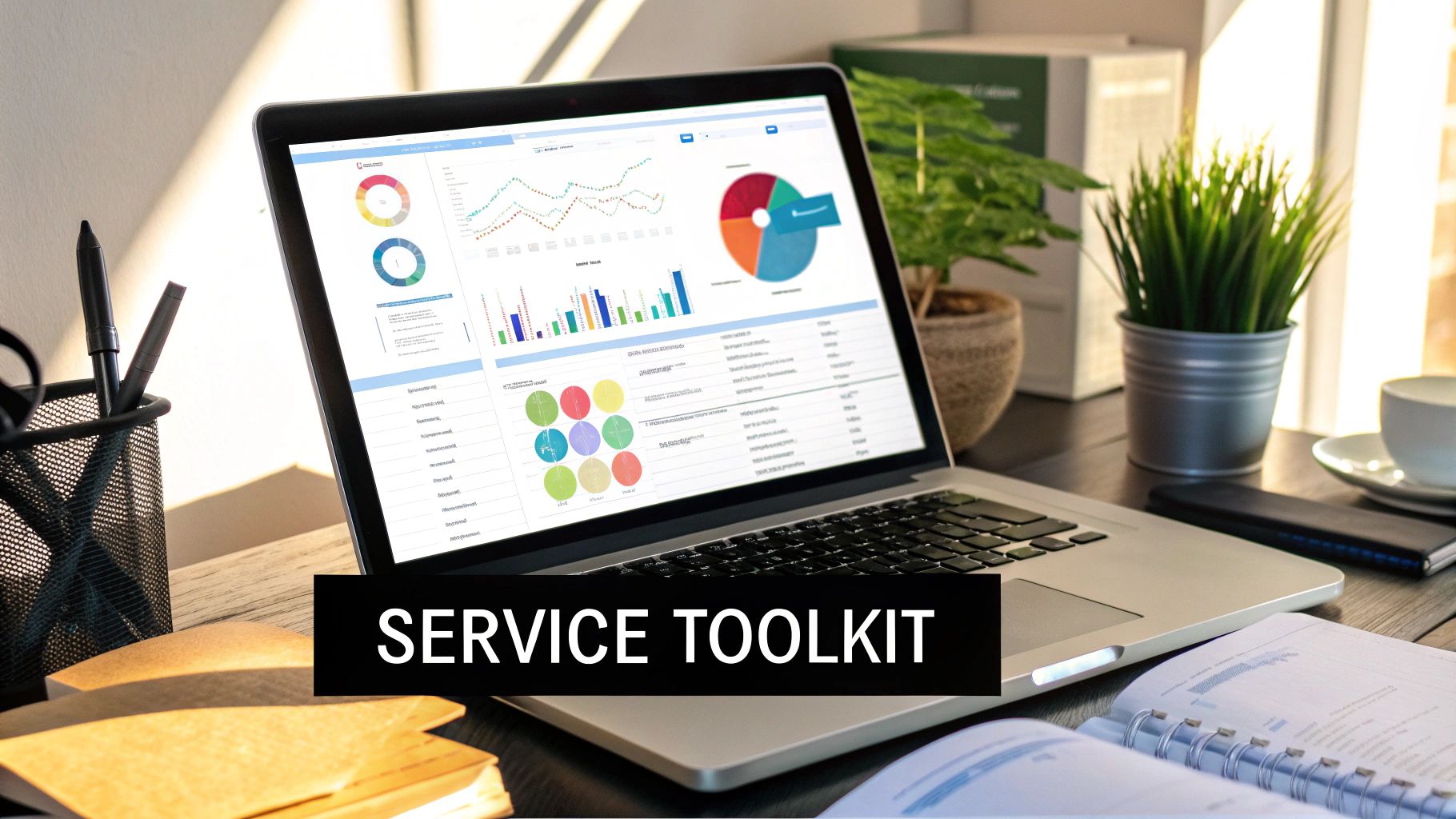Understanding What You Actually Need (Before You Start Shopping)
Jumping into the world of digital marketing without a clear plan is a recipe for a drained bank account. It’s easy to get caught up wanting everything—SEO, social media, paid ads—but this scattergun approach rarely pays off for a small business. Before you even think about looking for affordable digital marketing services, the first and most important move is to conduct an honest review of where your business is right now. What’s getting results? What’s falling flat? And most importantly, where are your real opportunities for growth?
For instance, imagine a local bakery with a strong word-of-mouth reputation but a nearly invisible online presence. They don’t need a complicated international SEO strategy. Their immediate need is much simpler and more effective: a well-optimised Google Business Profile and a basic social media page to show off their delicious daily creations. This is a far more affordable and impactful starting point.
Pinpointing Your Priorities
To avoid being sold services you don’t need, it's best to create a focused wishlist based on what matters most to your business. Think about what a "win" would look like for you in the next six to twelve months.
- Do you need to generate more leads? If so, your priority might be local SEO or targeted Google Ads. For businesses looking to improve efficiency, exploring strategies to automate lead generation can be a game-changer for faster growth.
- Is your goal to build brand awareness? In that case, creating great content and maintaining a consistent social media presence could be your main focus.
- Are you trying to increase online sales? An e-commerce SEO audit and conversion rate optimisation should be at the very top of your list.
Before you start your search, it helps to separate the absolute essentials from the "nice-to-haves." This table gives a practical look at where to focus your initial budget for the best return.
Essential vs. Nice-to-Have Digital Marketing Services
A practical comparison of must-have services versus optional add-ons for small businesses
| Service Type | Priority Level | Average Monthly Cost (AED) | Expected ROI Timeline |
|---|---|---|---|
| Local SEO & Google Business Profile | Essential | 1,000 – 3,500 | 3-6 Months |
| Basic Social Media Management | Essential | 1,500 – 4,000 | 4-8 Months |
| Content Marketing (Blog/Video) | High | 2,000 – 7,000 | 6-12 Months |
| Pay-Per-Click (PPC) Advertising | Medium | 1,800 + Ad Spend | 1-3 Months |
| Email Marketing | Medium | 500 – 2,500 | 2-6 Months |
| Advanced SEO (National/E-commerce) | Nice-to-Have | 5,000 – 15,000+ | 9-18 Months |
| Conversion Rate Optimisation (CRO) | Nice-to-Have | Project-based (Starts at 7,000) | 3-6 Months |
This table shows that foundational services like Local SEO are not only more affordable but also crucial for any small business starting out. More advanced services like national SEO or CRO can wait until you have a solid base and more budget to work with.
By focusing your resources on the one or two channels most relevant to your goals, you avoid spreading your budget too thin—a very common mistake. The market is huge; digital ad revenue in the MEA region, which includes the UAE, reached USD 31.99 billion in 2024. This massive figure shows just how many services are out there, making it critical to choose wisely. Learning more about digital advertising market trends can help you understand where the biggest opportunities are for your business.
Setting a Realistic Budget That Won't Sink Your Business

Let’s talk money. Figuring out your marketing budget can feel like walking a tightrope. If you don't invest enough, your efforts will likely fall flat. But overspending can put your business's financial health at risk. Instead of getting lost in complicated formulas, the simplest approach is often the best. A good starting point for established small businesses is to allocate 7-12% of your total revenue to marketing.
This percentage-based model doesn't quite work if you're a new business still finding your footing. Without a consistent revenue stream, it's better to build your budget around specific goals. For example, if your aim is to gain 20 new customers each month, you can work backwards. Figure out the lifetime value of an average customer, then determine what you can reasonably spend to acquire one. This method directly links your spending to tangible results, which is essential when you're searching for affordable digital marketing services.
Allocating Your Funds Wisely
Once you have your total budget, the next challenge is deciding where to spend it. Every marketing channel delivers different results, and your budget allocation should mirror your priorities. If your customers are primarily on social media, for example, putting more funds into video ads on those platforms makes sense. It's also helpful to get a handle on what agencies charge; this ultimate guide to understanding PPC agency pricing offers valuable insights into how costs can differ.
The market in the MENA region is growing quickly, with internet advertising spending expected to reach USD 7.9 billion in 2024. It's telling that over 44% of this spend is directed towards video, highlighting a clear preference for engaging, dynamic content. You can learn more about these regional advertising trends to better inform your spending decisions.
A practical way to structure your budget is the 70/20/10 rule:
- 70% for proven strategies: Put the majority of your budget into what you know works. If Google Ads or local SEO consistently brings in customers, keep funding them.
- 20% for new channels: Use this slice to experiment with new platforms. This could be a small test campaign on TikTok or running a few ads on LinkedIn to see what happens.
- 10% for a buffer: Always keep a small reserve. You can use it for unexpected opportunities or to boost a test campaign that's performing exceptionally well.
This approach provides stability by focusing on reliable channels while leaving room for discovery and growth. For a deeper dive, be sure to read our guide on how to master your small business marketing budget.
Finding Quality Partners Without Getting Overwhelmed

Trying to find affordable digital marketing services can feel like you're lost in a sea of lookalike websites, all promising the moon. The trick is to look past the flashy claims and figure out who can actually follow through. Instead of a generic online search, a great starting point is asking for recommendations from other business owners in your circle. A genuine referral from someone who’s seen tangible results is often worth more than any sales pitch.
As you start looking at potential partners, the details really matter. A credible agency will have clear, easy-to-find case studies with real data, not just fluffy testimonials. For example, if you're running an e-commerce shop, learning how to choose the right Shopify marketing agency gives you a solid checklist for vetting any potential partner, no matter what platform you use. This kind of specific, practical advice is what separates genuinely helpful resources from generic filler.
Spotting Red Flags and Green Lights
Knowing what to watch out for can save you from a costly mistake. Vague proposals, a lack of transparent pricing, or an unwillingness to talk about past projects that didn't go as planned are major red flags. On the flip side, a great partner will be keen to understand your business goals before they even bring up a contract.
A recent survey showed that digital ad buyers in the MENA region are focusing more on cost-effective formats that get high engagement. This means an agency needs to be skilled in more than just basic ad placements. Ask them how they handle performance-based strategies. You can discover more insights about MENA digital ad growth on altmansolon.com.
Finally, think about whether a freelancer or an agency is a better fit for you.
- Freelancers often bring specialised skills and flexibility at a lower price point, which is perfect for specific, one-off projects.
- Agencies offer a complete team with a wider range of abilities, making them a better choice for a more comprehensive strategy.
The right choice comes down to your unique needs. If you're just getting started, our advice on digital marketing for startups can help you figure out which path is the best for your business right now.
Comparing Proposals Like a Pro (Without the Marketing Jargon)
Once you've shortlisted a few potential agencies, the proposals will start rolling in. It’s easy to feel like you're drowning in a sea of documents, each one packed with impressive-sounding terms that don't actually tell you what you're paying for. The trick is to slice through the jargon and zero in on what will directly impact your business goals. A good proposal should read like a clear plan of action, not a vocabulary test.
For instance, don't get swept away by vague promises of "increased brand visibility." Instead, push for specific, measurable outcomes. What does that visibility mean in real terms? Are they guaranteeing a certain number of qualified leads, a specific percentage increase in website traffic from your target audience, or a particular return on ad spend (ROAS)? These are the metrics that matter to your bottom line. A recent analysis of marketing strategies found that tracking leads to their source is vital for knowing how effectively each dirham is spent. This level of detail is what separates a true professional from someone just making noise.
From Jargon to Clarity
To help you compare different proposals for affordable digital marketing services, it’s useful to see what various cost structures look like in the real world. The infographic below shows average monthly costs for a few core services you might be considering.
As you can see, services like content marketing have a pretty wide price range. This makes it even more important to get crystal clear on exactly what deliverables are included for the price you’re quoted.
What to Scrutinise in a Proposal
Beyond the headline numbers, it’s the small details that reveal the quality of a proposal. A solid plan for affordable digital marketing services will meticulously break down the costs, timelines, and exactly what you can expect. Here’s a quick checklist of things to look for:
- Clear Deliverables: The proposal must list precisely what you get for your money. If they’re handling social media, does that mean 10 posts a month or 20? For SEO, are they covering technical audits, content creation, and link-building, or just one piece of the puzzle?
- Realistic Timelines: Digital marketing isn’t an overnight success story. A trustworthy agency will manage your expectations, often pointing out that seeing meaningful results, especially from SEO, can take three to six months. Be very cautious of anyone promising you instant first-page rankings on Google.
- Reporting and Communication: How often will you get updates, and what will they look like? A great partner will set up regular check-ins and provide reports that are easy to understand and clearly connect their activities to your business goals.
Sorting through proposals can feel overwhelming, but knowing what to look for makes the process much simpler. A great proposal will feel less like a sales pitch and more like the beginning of a strategic partnership. To help you quickly spot the good from the bad, I've put together a table comparing the red flags to watch out for against the green flags that signal a promising partner.
| Element | Red Flag | Green Flag | What It Means |
|---|---|---|---|
| Pricing | Vague, bundled pricing with no itemised breakdown. | A clear, itemised list of services and their individual costs. | A green flag shows transparency and helps you understand exactly where your money is going. |
| Deliverables | Uses fluffy language like "boost engagement" or "increase visibility." | Lists specific, quantifiable deliverables (e.g., "12 blog posts per month," "2 custom reports"). | Specifics show the agency has a concrete plan and can be held accountable for their work. |
| Timelines | Promises overnight success or "guaranteed #1 rankings." | Provides a realistic timeline, explaining that SEO can take 3-6 months to show results. | Honesty about timelines builds trust and shows the agency understands how digital marketing actually works. |
| KPIs & Reporting | Focuses on vanity metrics like "impressions" or "likes" without context. | Proposes KPIs tied to your business goals (e.g., leads, conversion rate, ROAS). | A focus on business-centric metrics means the agency is aligned with your definition of success. |
| Strategy | A generic, one-size-fits-all plan that could apply to any business. | A customised strategy that references your specific business, industry, and competitors. | A personalised approach indicates the agency has done its homework and is genuinely invested in your success. |
| Communication | No mention of a communication schedule or a dedicated point of contact. | Outlines a clear schedule for meetings and reports, and names your account manager. | A green flag here signals a commitment to a collaborative and transparent partnership. |
Ultimately, the best proposals are those that demonstrate a clear understanding of your business and lay out a logical, measurable plan to help you grow. Green flags across the board are a strong indicator that you’ve found a partner who is serious about delivering real value.
Making the Final Decision and Setting Up for Success
You’ve carefully gone through the proposals and now it’s time to make the final call. While all the data and costs are important, don't ignore your gut feeling. If an agency looks great on paper but the conversations felt a bit off, it’s a good idea to press pause. A great partnership, especially for affordable digital marketing services, is built on clear communication and mutual respect. You'll be working closely with these people, so trusting your intuition is often a smart move for a smooth collaboration.
Once you've picked your winner, the next move is to make it official and set clear expectations right from the start. This all begins with the contract. A solid agreement is your safety net, protecting both you and the agency. It needs to cover more than just the price and payment dates; it should spell out exactly what work will be done.
Laying the Groundwork for a Strong Partnership
A fuzzy contract can lead to a lot of headaches and misunderstandings down the road. Before you sign on the dotted line, make sure the document is crystal clear on a few key points. Think of it as creating a shared rulebook that everyone can refer to.
Here’s a breakdown of what your agreement should cover in plain terms:
- Specific Deliverables: Vague promises won't cut it. The contract should list the exact number of blog posts, social media updates, or reports you’ll get each month.
- Performance Benchmarks: How will you know if the marketing is actually working? Agree on specific key performance indicators (KPIs) like the number of new leads, conversion rates, or a target cost per acquisition (CPA).
- Communication Protocol: Set a clear rhythm for check-ins. For instance, you might agree to a bi-weekly call and a monthly performance report. Also, know who your main point of contact is.
- Termination Clause: What’s the plan if things don't work out? A clear exit strategy, detailing the notice period and what happens with any final work, is essential for your peace of mind.
Putting all these details in writing isn't about a lack of trust. It’s about building a professional and transparent foundation for your partnership. This simple step helps make sure your investment in affordable digital marketing services is set up to deliver real results from day one.
Managing Your Investment and Measuring Real Results

Hiring affordable digital marketing services is a fantastic first step, but the real work starts now. Your ongoing involvement is key to making sure your investment leads to genuine growth, not just busywork. This doesn't mean you need to micromanage every detail. Instead, focus on setting up a solid rhythm of communication and understanding the reports your new partner sends over. The aim is to build a collaborative relationship, not just a transactional one.
The first few months are often a learning curve for both of you. Your marketing team is figuring out your brand voice and audience, while you're getting used to their data. It's completely normal for results to feel a bit slow at the beginning. For example, SEO and content marketing are long-term strategies; you can't expect a huge jump in traffic in the first month. A good agency will set these expectations with you from the outset.
Knowing What to Track and When to Act
To manage your investment well, you need to look past "vanity metrics" like likes or impressions. These numbers might look good on a report, but they often have very little to do with your actual business goals. Instead, centre your conversations around the numbers that directly connect to your revenue and growth.
Here’s what you should be discussing in your regular check-ins:
- Cost Per Acquisition (CPA): This is the big one. How much are you actually spending to get one new customer?
- Conversion Rate: What percentage of people visiting your website are taking the action you want them to, like filling out a contact form or buying something?
- Lead Quality: Are the leads you're getting a good fit for your business, or are they a waste of time? A high volume of leads means nothing if none of them become customers.
If you see that your CPA is creeping up or the quality of leads is dropping, it’s time to have an open conversation. Ask your agency what they're seeing on their end and what adjustments they suggest. Successful partnerships are built on this kind of direct, data-driven dialogue. For a more detailed guide, you can learn more about effective marketing campaign tracking and how it helps you make smarter decisions.
If you’re ready to partner with a team that believes in real results and transparent communication, Technogital is here to help. Contact us today to see how our affordable digital marketing services can drive measurable growth for your business.

